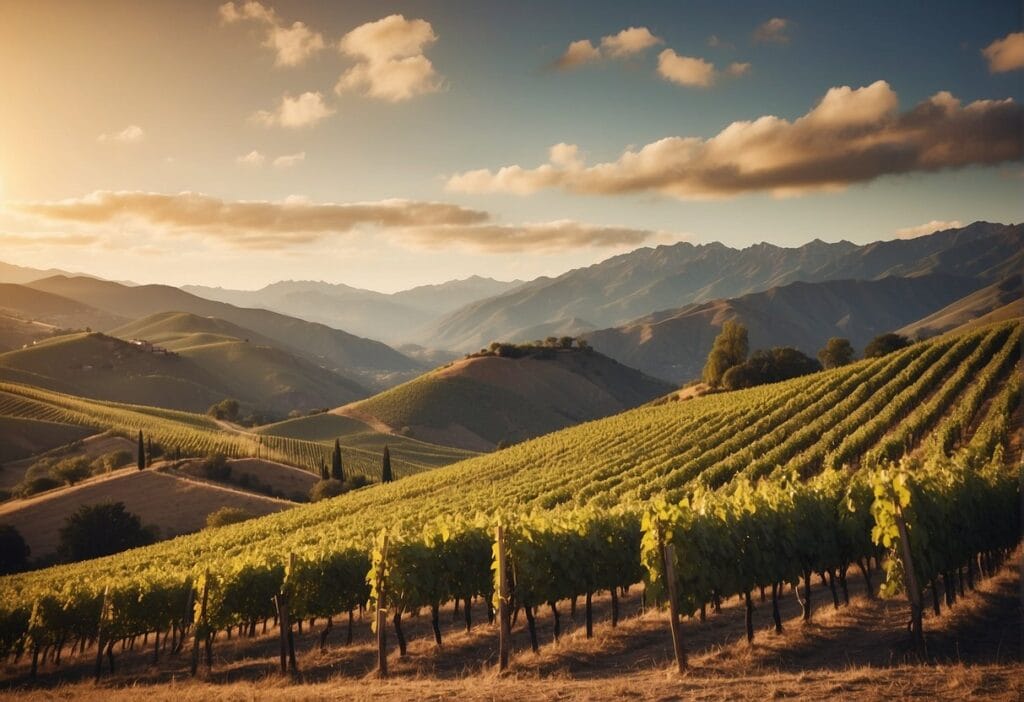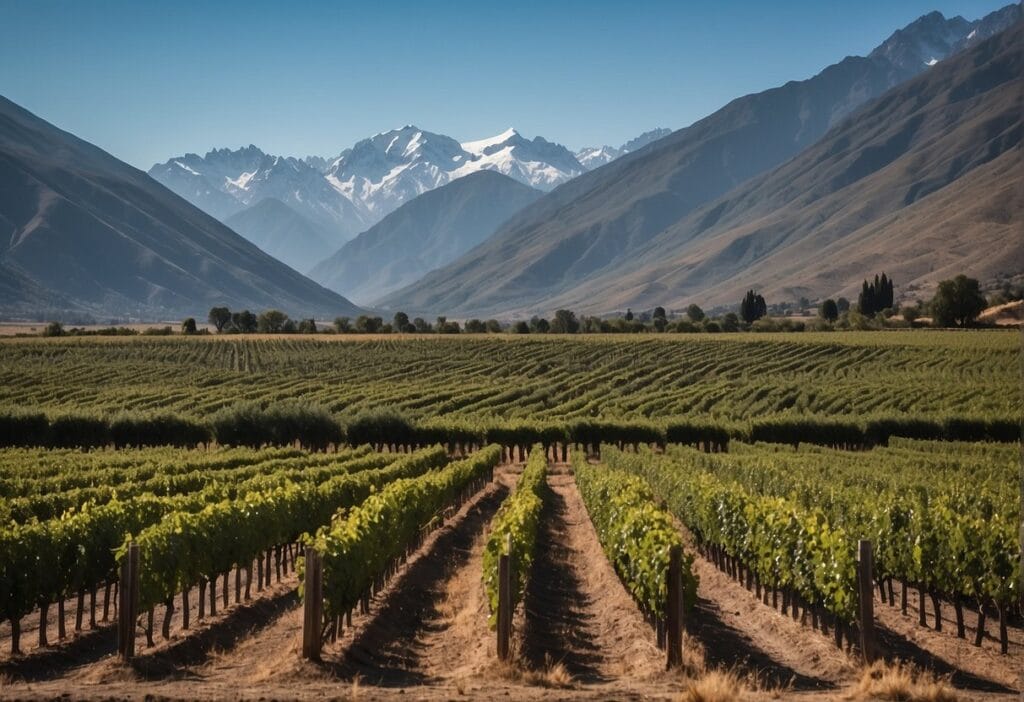Argentina, a land of vibrant culture and diverse landscapes, is also renowned for its exquisite wines. As you explore the Argentine wine regions, you’ll uncover a world where viticulture thrives in the shadow of the majestic Andes mountains.
These towering peaks not only create a striking backdrop for the vineyards but also play a crucial role in the terroir, influencing the climate and contributing to the unique character of Argentine wines.
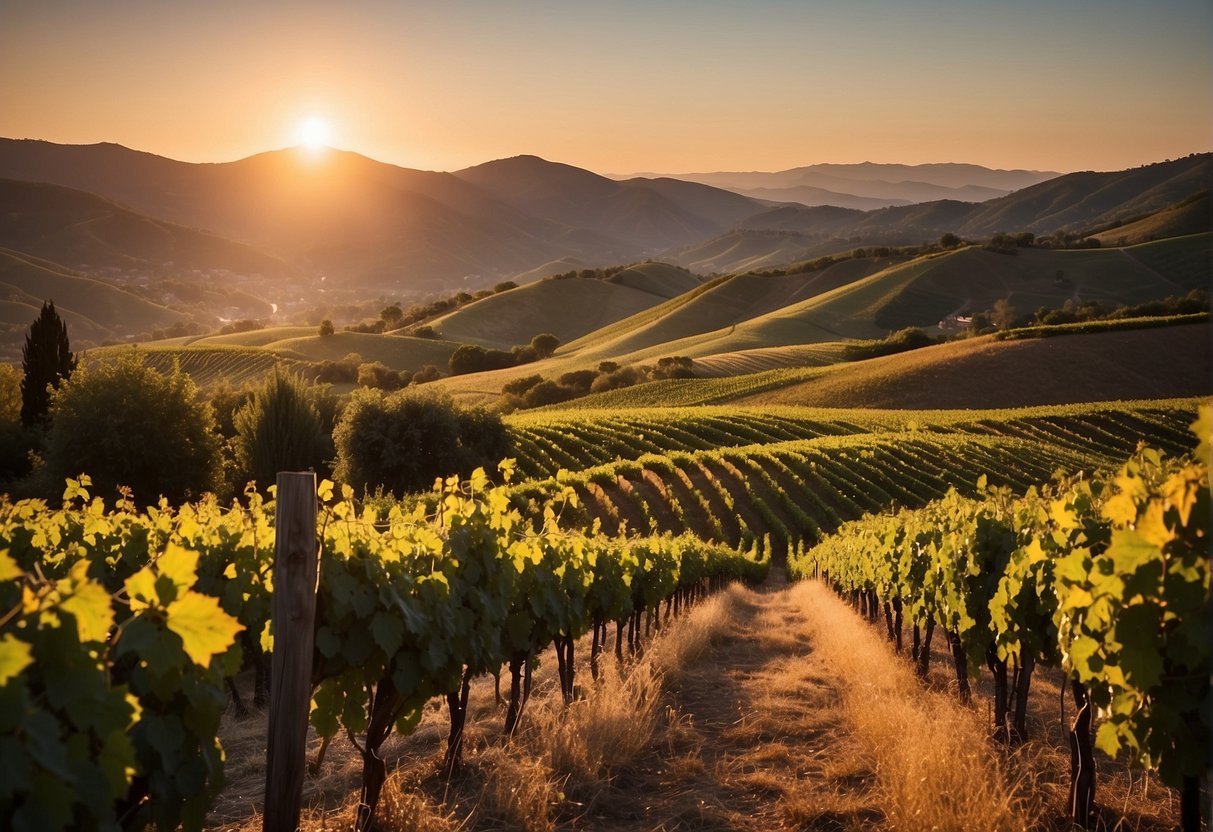
Mendoza stands out as the heart of Argentina’s winemaking; its name almost synonymous with the country’s premium Malbec. But the wine regions of Argentina extend beyond, enveloping the arid landscapes of Patagonia and reaching up to the northern provinces like Salta, where some of the highest vineyards in the world can be found. Here, a mix of traditional methods and innovative techniques come together to shape the Argentine wine narrative.
Whether you’re a seasoned connoisseur or a curious novice, Argentina’s wines promise a diverse palette, ranging from robust reds to crisp whites, each bottle a reflection of its origin.
Key Takeaways
- The Andes mountains influence the climate and viticulture of Argentine wine regions.
- Mendoza is the most prominent wine region in Argentina, but other areas like Patagonia and Salta are also noteworthy.
- Argentine wines are diverse, embracing a range of styles and grape varieties, with a special focus on Malbec.
Overview of Argentina’s Wine Regions
When you explore Argentina’s wine regions, you’re embarking on a journey through some of the most diverse and picturesque vineyards in the world. Let’s dive in!
Mendoza: The Heartland of Argentine Wine
You’ll find that Mendoza is the powerhouse of the Argentine wine industry, with an impressive array of wines primarily sourced from this region. Mendoza’s vineyards thrive at the foothills of the Andes Mountains, benefiting from the high altitude and arid climate synonymous with exceptional Malbecs.
- Popular Varieties: Malbec, Cabernet Sauvignon, Chardonnay
- Sub-regions: Maipú, Luján de Cuyo, Valle de Uco
Patagonia: The Cool Climate Gem
Venture to the southern reaches of Argentina and discover Patagonia. This is a region gaining recognition for its cool climate which is ideal for producing Pinot Noir and Merlot.
- Notable Sub-regions: Neuquén, Río Negro
Salta: High-Altitude Wonders
Experience the wines of Salta, where some of the world’s highest vineyards lie. The unique terroir here expresses itself through highly concentrated flavors, especially in the region’s Torrontés.
- Sub-regions: Cafayate
Cuyo: More Than Mendoza
Although Mendoza is a part of the larger Cuyo region, don’t miss out on exploring other areas in Cuyo, like San Juan, which also offers high-quality wines.
- Notable Varieties: Syrah, Viognier
Wine Maps and Guides
If you’re wanting to delve deeper into your understanding of these regions, a map of Argentina’s wine regions can be a great visual guide. It not only illustrates the location of each wine region but also offers insight into the terroir and variety that make Argentine wine so distinctive.
Keep this guide handy as you taste your way through Argentina’s unique landscapes and wines!
The Influence of the Andes on Viticulture
The Andes Mountains play a critical role in shaping the unique terroir and climate that allow Argentina’s vineyards to thrive, particularly affecting vine growth at high altitudes and contributing to ideal grape ripening conditions through significant diurnal temperature variation.
Climate and Weather Patterns
The Andes are pivotal in creating the distinct climate conditions that you’ll find in Argentina’s wine regions. They act as a natural barrier that blocks Pacific Ocean moisture, creating a rain shadow effect on the east side where many vineyards lie.
This leads to arid conditions, compelling grapevines to delve deep into the soil for water, thus enhancing the terroir’s influence on the grapes. Due to this, irrigation is often essential, and melting snow from the Andes provides a vital water source.
High Altitude Viticulture
Viticulture at high altitudes introduces unique characteristics to Argentine wines. Vineyards situated between 800 to 3,000 meters above sea level, the grapes experience intense sunlight which, in turn, helps to develop thicker skins that contribute to robust, flavorful wines.
Moreover, the high altitude contributes to a diurnal temperature variation, with warm days and cool nights, which is key for preserving acidity and achieving a balance between sugar and phenolic maturity in grapes. This high elevation viticulture is a signature of Argentine winemaking, with the Mendoza region’s vineyards averaging at a breathtaking 900 meters with some in Salta, among the highest in the world.
The Major Wine Regions of Argentina
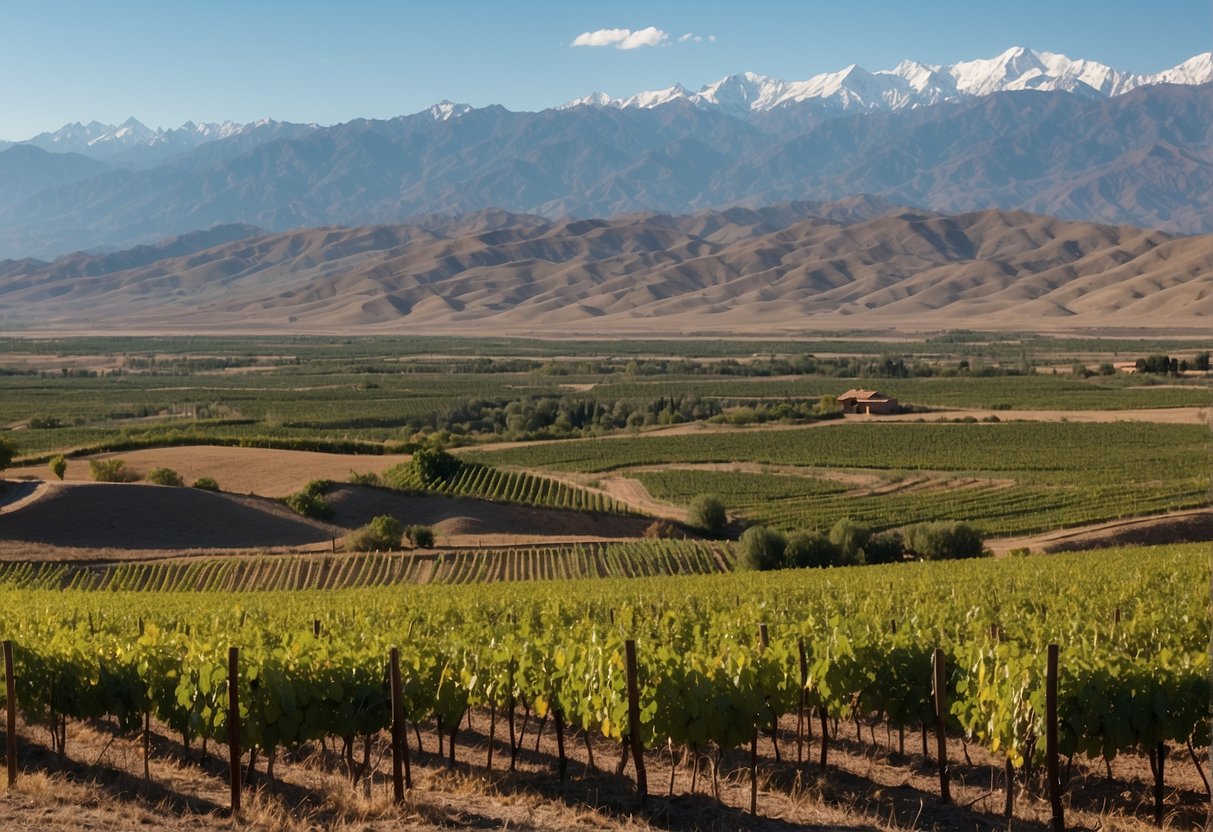
Argentina, known for its rich viticulture, is one of South America’s most prominent wine-producing countries. You’ll find a diverse array of wine regions here, each offering a unique flavor profile and atmosphere.
In the heart of Argentina’s wine country lies Mendoza, a region synonymous with Mendoza Malbec wines. This region is split into several sub-regions like Maipú and Luján de Cuyo with the latter known as the ‘land of Malbec’. Exploring Uco Valley, you’ll discover not only Malbec but also other varieties, as the area is gaining fame for producing superb Cabernet Sauvignon and Chardonnay.
To experience something a bit cooler in terms of climate, venture to Patagonia. The regions of Rio Negro and Neuquén within Patagonia are noted for their exceptional Pinot Noir and Merlot, thriving in the cooler conditions.
Heading north, Salta might catch your attention. The wines from the Calchaquí Valley, especially their Torrontés, are remarkable due to the high altitude vineyards, some of the highest in the world. Your palate might thrill to taste their uniquely aromatic whites that this region proudly offers.
On the western side, don’t miss San Juan, Argentina’s second-largest wine region, where Syrah is the star. Adjacent to San Juan, La Rioja is also noteworthy, being one of the oldest wine regions in the country and where the aromatic Torrontés Riojano really shines.
Lastly, explore the less-traveled but equally charming Catamarca, which contributes to the country’s wine mosaic with its own notable varieties.
Mendoza Region
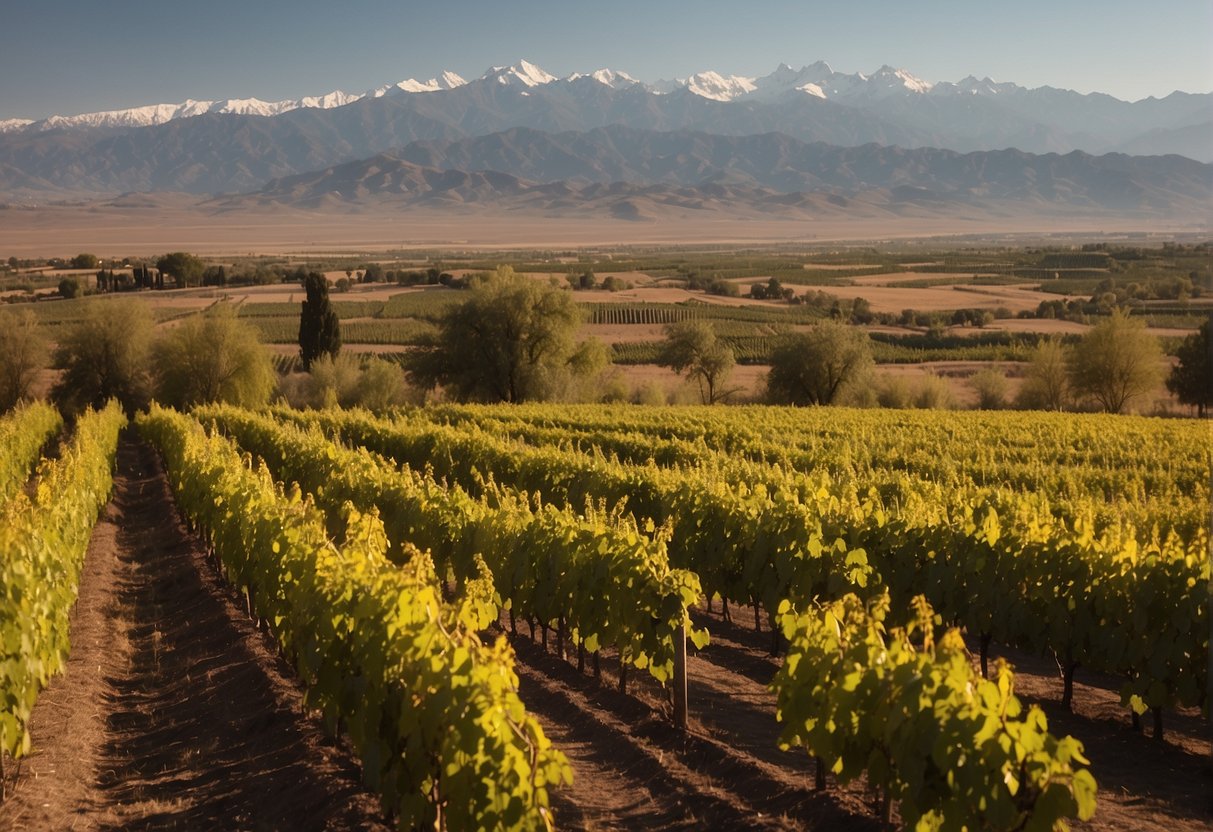
Nestled in central-western Argentina, Mendoza is the heartthrob of Argentine winemaking. Your curiosity about fine wines and breathtaking sceneries leads you here, to a place almost the size of Illinois. Imagine yourself dwarfed by the Andes Mountains to the west, an awe-inspiring backdrop to the vineyards.
In Mendoza, you find a unique blend of natural factors that contribute to its wine’s distinct character. The Andes Mountains play a crucial role, providing a natural barrier that limits rainfall, creating a semi-arid climate ideal for vine growth.
Here’s what makes Mendoza wine country special:
- Altitude: Some vineyards sit at elevations as high as 3,600 feet above sea level, among the highest in the world for viticulture.
- Irrigation: Ingenious use of meltwater from Andean snow provides life to the vines.
- Sunshine: Abundant sunshine ensures optimal grape ripening.
When you explore the wine estates, you’ll often hear about Malbec — Mendoza’s flagship variety. But there’s more to taste and see!
| Main Varieties | Description |
|---|---|
| Malbec | Rich, dark fruit flavors |
| Torrontés | Floral and aromatic |
| Cabernet Sauvignon | Bold with notable tannins |
Local experts might guide you through three key subregions: Maipu Valley, Lujan de Cuyo, and Uco Valley, each offering distinct expressions of terroir.
Patagonia Region
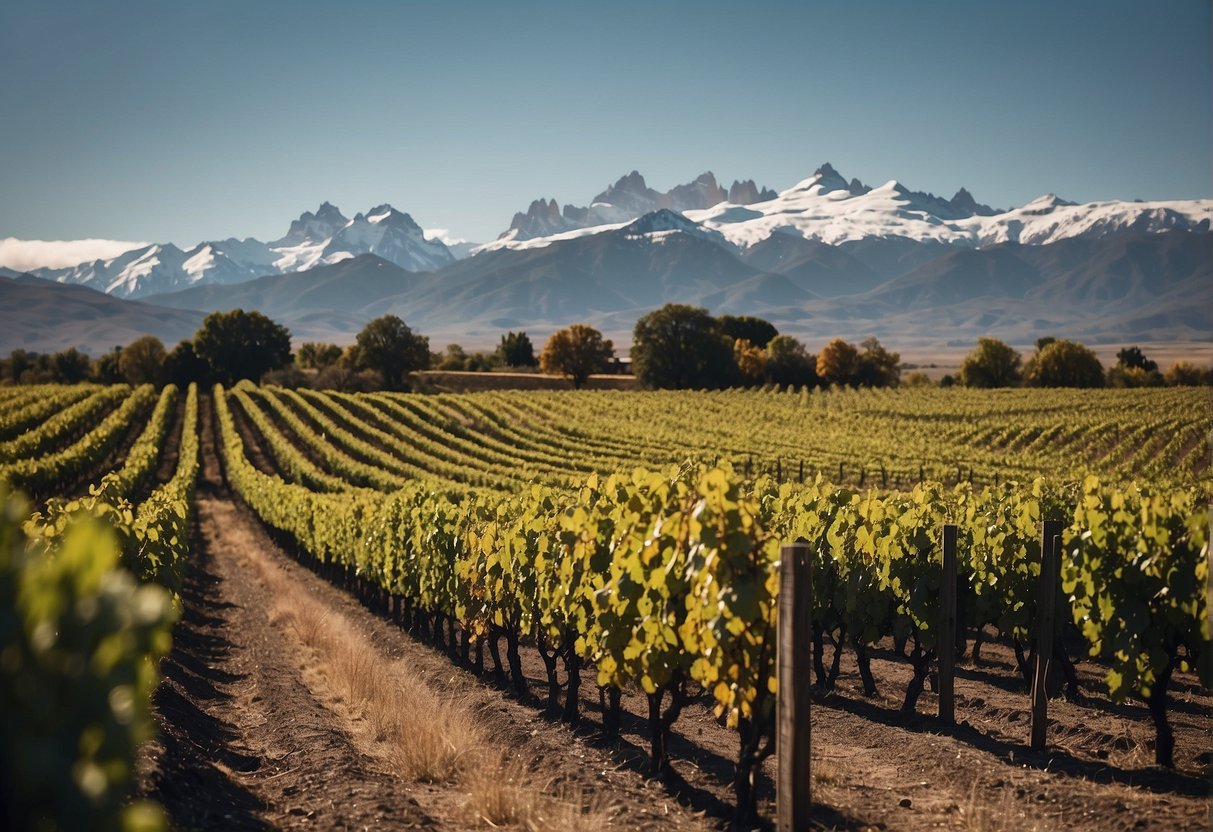
In your exploration of Argentina’s wine country, you’ll be charmed by the Patagonia region. It’s the southernmost wine-producing area in the country. The region offers cool climates that are ideal for growing certain grape varieties.
Grape Varieties
- Pinot Noir: Elegantly expresses the terroir.
- Malbec: Displays a unique profile different from those of higher altitude regions.
As you immerse yourself in the world of Patagonian wines, you’ll encounter regions like Neuquén and Río Negro. These areas present the wild and less-traveled paths of Argentina’s wine map.
If you’re looking for these distinctive wines, check labels for appellations such as Río Negro and Neuquén to guide your selections.
The region’s wine production benefits from the dry climate and the natural barrier provided by the Andes. The Andes protect the vineyards from excessive rain and pests. The wines from Patagonia often exhibit a balance of fruit and acidity, making them versatile for food pairing.
Winery Visits
- Bodega Favretto: Enjoy a visit to taste the local offerings from one of Patagonia’s producers.
- Wineries in Chubut: Discover up-and-coming estates pushing viticultural boundaries.
Patagonia’s wine country extends to the provinces of La Pampa and Neuquen, which you can explore for a broader taste of the region’s bounty. For a comprehensive guide to the wineries and wines of this region, consider Wine Folly’s detailed overview of Patagonia.
If you’re captivated by the extreme conditions and the resulting exceptional wines of Patagonia, you can delve into fascinating discussions about the winemaking practices in this unique setting. Whether you’re a seasoned connoisseur or new to Argentine wines, Patagonia offers a distinct and memorable wine-tasting experience.
Salta Region
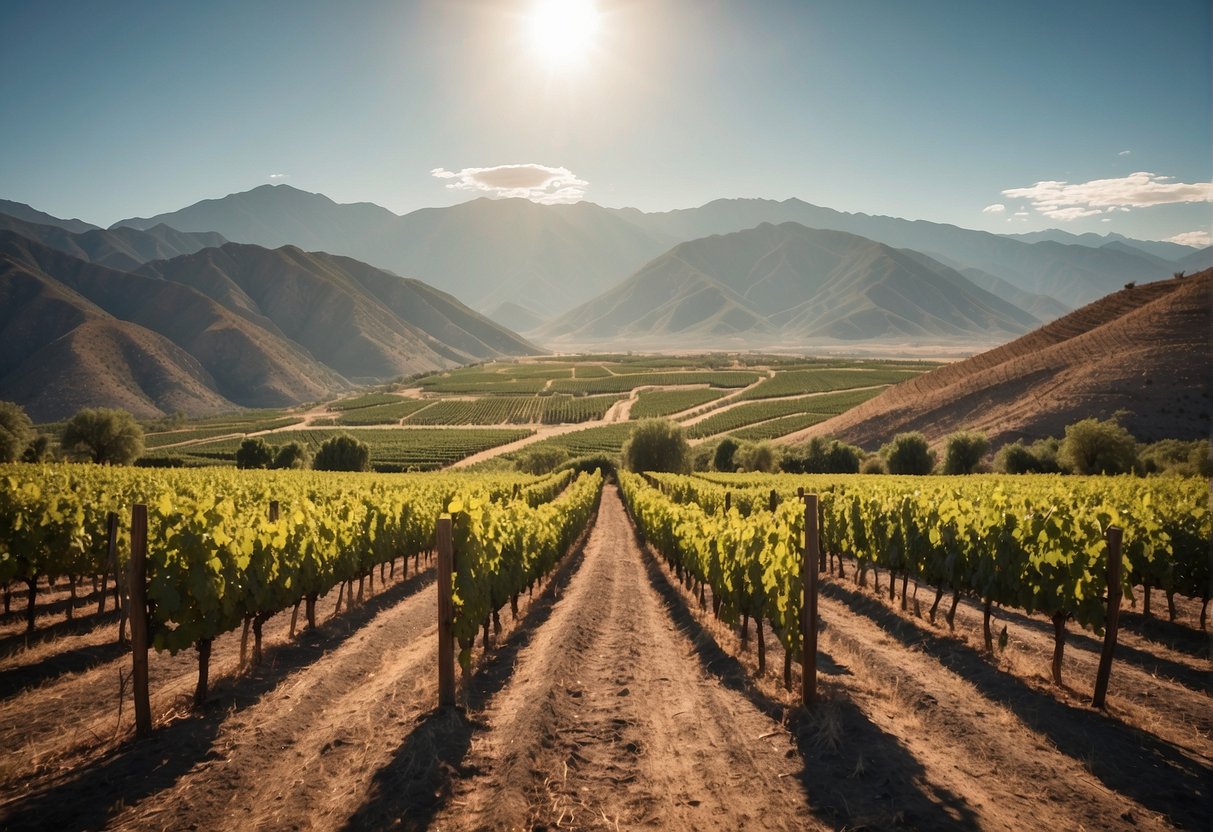
When you explore Argentina’s wine regions, the Salta region undoubtedly stands out, possessing a unique charm and an impressive altitude for vineyard cultivation. Nestled in the north part of Argentina, Salta offers you breathtaking views of vineyards set against the backdrop of the Andean landscapes.
The key areas within the Salta wine region include:
- El Arenal: Known for its high-altitude vineyards.
- Cafayate: Gaining international acclaim for the quality of its wines.
- Molinos: Home to some of the world’s highest vineyards.
You’ll find that the terroir in Salta is distinct, with a rain-shadow effect contributing to the hot, dry conditions perfect for producing wines with a concentrated flavor. In particular, the grape varieties that flourish in this region are:
| Grape Variety | Characteristic Notes |
|---|---|
| Torrontés | Aromatic, with floral and citrus notes. |
| Malbec | Robust, with dark fruit flavors. |
| Tannat | Strong, with high tannin content. |
Torrontés is a must-try when you visit Salta. As Argentina’s signature white grape, it’s truly at home in the high-elevation vineyards of Cafayate, offering an experience of taste that speaks to the region’s uniqueness. A tour of the Salta wine region might lead you to small family-run wineries or boutique estates where you can savor these varietals amidst stunning scenery.
Each vineyard visit in Salta invites an intimate connection with Argentina’s wine tradition, with many wineries providing engaging tours and tastings. If you’re looking to venture into an area rich with vinicultural history and distinct flavors, Salta is a destination that should certainly be on your map.
Principal Grape Varieties and Wine Styles
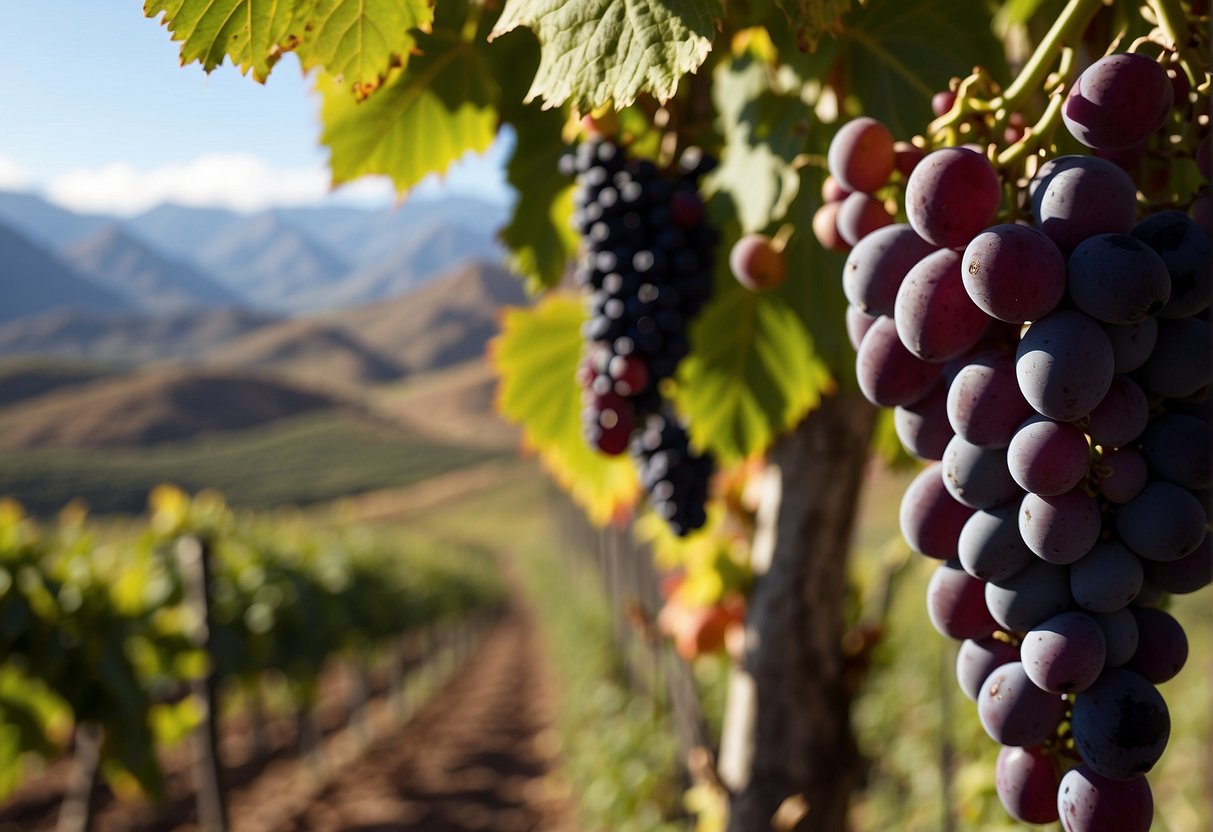
Argentina offers a rich tapestry of grape varieties and wine styles, each with its own distinct character. Dive into this well-crafted vibrancy through the signature reds, elegant whites, and the unique varietals that are as diverse as the country’s landscapes.
Signature Reds
Argentina’s red wines are recognized worldwide, with Malbec being the most celebrated among them.
You will find Malbec wines exhibit a deep ruby color, often full-bodied with ripe berry flavors and smooth tannins. They pair splendidly with grilled meats, a traditional Argentine asado.
- Cabernet Sauvignon: Offers a more structured taste, bearing dark fruit flavors and a hint of spice. It’s an excellent choice for aging.
- Syrah: Known for its robust profile and peppery notes, Argentinian Syrah is a definitive choice for those who appreciate intensity and complexity.
Other notable red varieties include Bonarda, which provides a softer palate of plums and cherries, Cabernet Franc, known for its spicy and herbaceous qualities, and Merlot, offering a suppler fruit profile with hints of chocolate.
Elegant Whites
Argentina’s white wines are equally compelling, with Torrontés being the star, often described as the country’s flagship white.
This grape variety yields fragrant wines that are crisp and aromatic with floral and citrus notes. It’s your go-to for a refreshing drink on a warm day.
- Chardonnay: Expressing a broader range of styles, from the unoaked, mineral-driven to the richer, barrel-fermented versions, these wines can be both bright and complex.
- Sauvignon Blanc: Often crisp and zesty, providing a refreshing sip with green and citrus fruits at the fore.
Unique Regional Varietals
Argentina is also home to some unique regional varietals that reflect the diverse terroir of the country.
- Cereza and Criolla Grande: These are traditional Argentine grapes used primarily for table wines, representing the winemaking history and heritage of the region.
- Tempranillo: Although more closely associated with Spain, Tempranillo has found a new expression in Argentina. It often delivers earthy and bramble-driven wines.
Wine Production and Winemaking Techniques
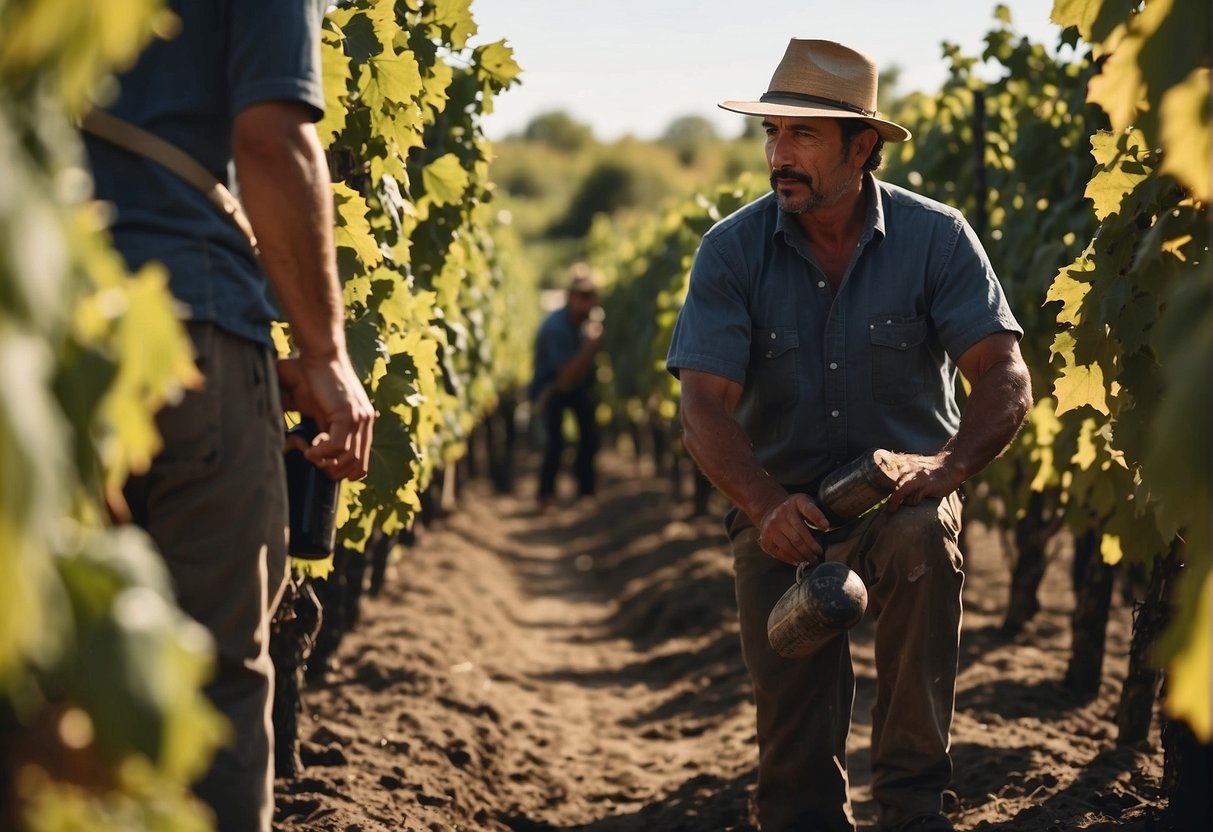
Argentina is renowned for its wine production, which has been honed over centuries. As you explore Argentinian winemaking techniques, you’ll discover the meticulous care that goes into cultivating each grape and transforming it into a sumptuous bottle of wine.
In the vineyards, the journey begins with the choice of grape variety. Malbec may be the most famous, but Argentine winemakers also cultivate a variety of other grapes, enriching the country’s wine portfolio.
| Grape Varieties | Popular Regions |
|---|---|
| Malbec | Mendoza, Patagonia |
| Torrontés | Salta |
| Cabernet Sauvignon | San Juan |
Once harvested, the winemaking process requires finesse. Modern and traditional techniques are embraced, where the fermentation process might see innovative approaches, such as microvinification in small tanks to highlight distinct flavors.
One cannot discuss Argentinian wine without mentioning the role oak barrels play. These barrels impart a complexity and robustness to the wine, a signature noted especially in red varieties.
Aging in oak helps round out the tannins and add subtle vanilla or chocolate notes, depending on the type of wood used.
| Winemaking Step | Technique |
|---|---|
| Fermentation | Controlled Temperature |
| Aging | Oak Barrels |
Vineyards and Terroir: A Focus on Geography
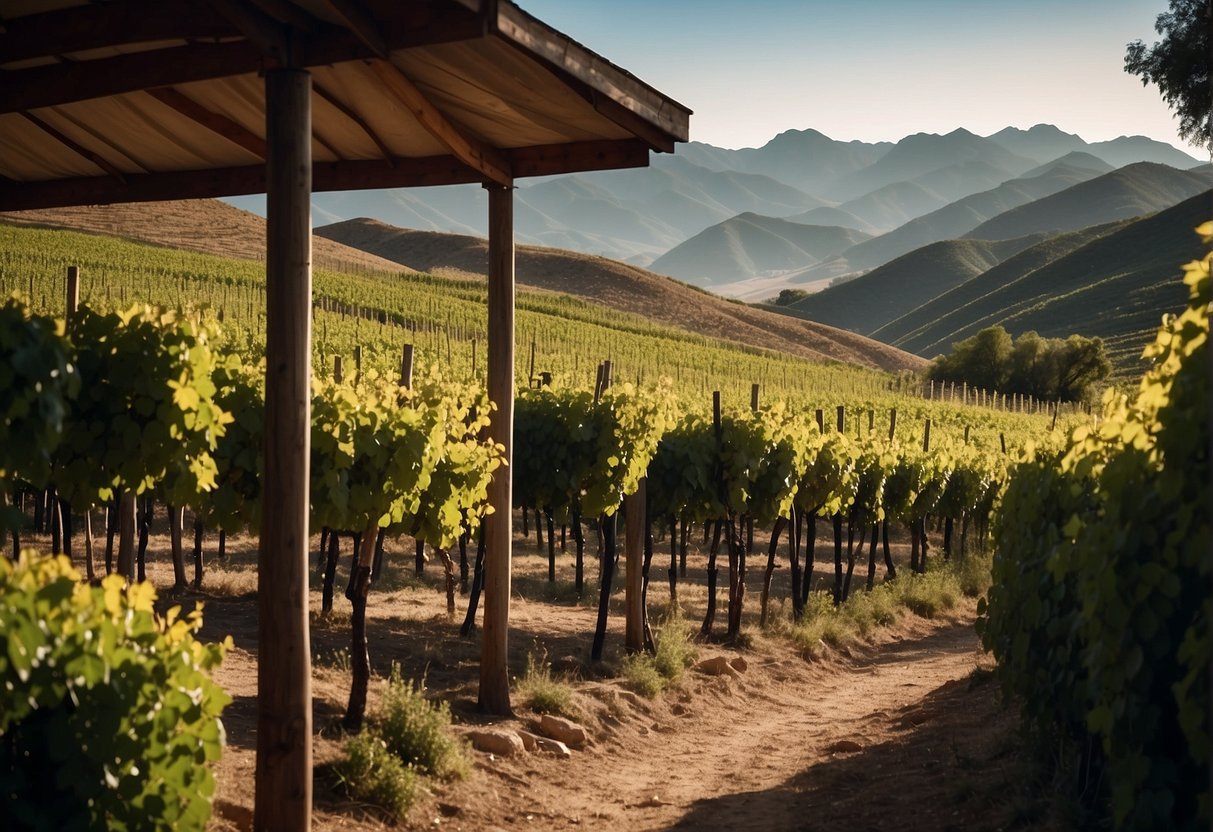
Exploring Argentine vineyards through the lens of geography reveals how diverse soil types and precise mapping contribute to the exceptional terroir.
Mapping Out Vineyards
Cutting-edge techniques like Geographic Information Systems (GIS) play a pivotal role in understanding vineyard distribution in Argentina.
Using GIS, winemakers can create a detailed map that visualizes the intricate tapestry of vineyards across varied landscapes. These maps can illustrate factors ranging from altitude variations to proximity to water sources.
For example, Mendoza, a key wine region, can be dissected into sub-regions like Luján de Cuyo and Valle de Uco. Each sub-region has its own distinct geographical characteristics and Geographical Indications.
Soil Types and Terroir
Soil is the foundation of terroir, and Argentina’s vineyards are renowned for their rich diversity. Each region’s soil contributes unique characteristics to the wine:
- Sandy soils in parts of Mendoza, where old vines resist phylloxera and produce concentrated flavors.
- Clay soils in the Uco Valley, offering robust structure to the wines.
- Soils with alluvial deposits near the Andes, enhancing mineral notes in the grapes.
This variation in soil types, coupled with vineyards that often sit at high elevations – some well above sea level – leads to a wide array of wine styles and complexities that your palate can explore.
Viticulture in Argentina
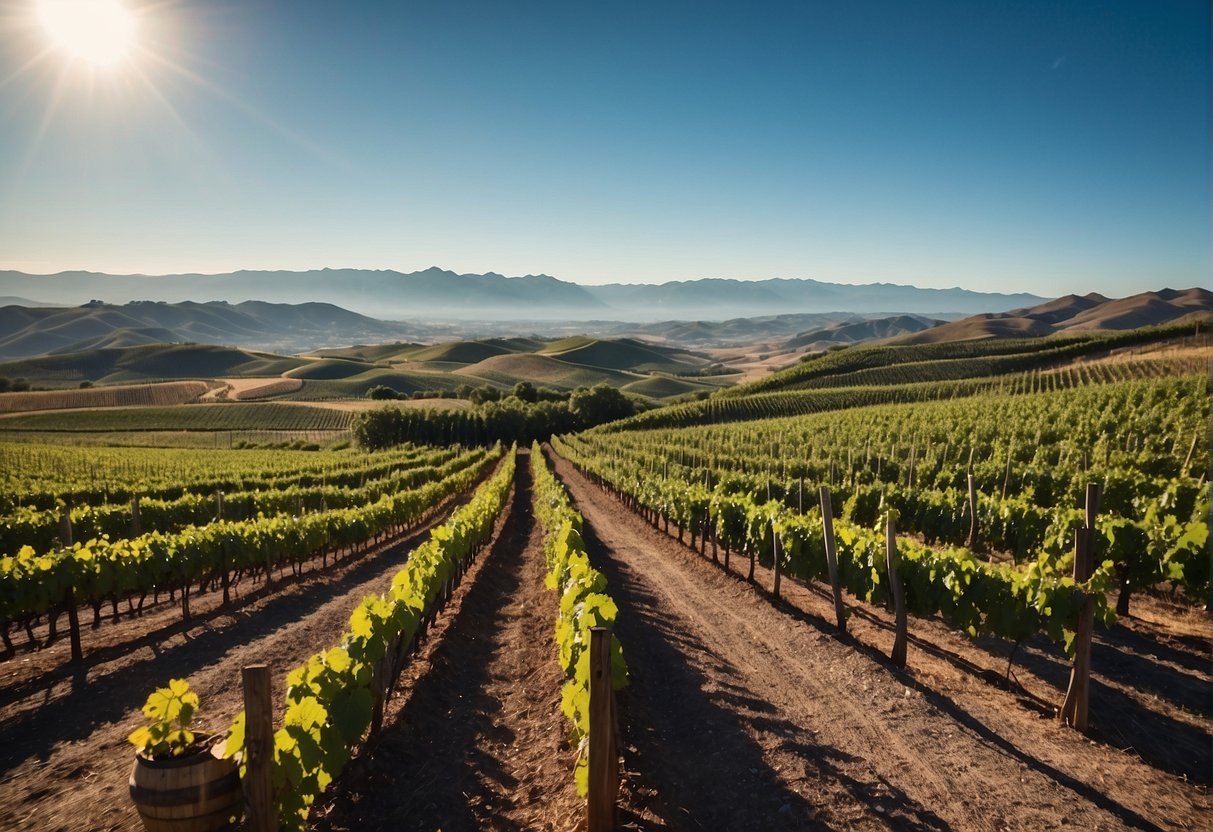
Argentina’s viticulture is a pivotal aspect of the country’s agricultural pride. It offers a rich tapestry of wines that reflect its diverse climate and geography.
The production of wine in Argentina is notably significant. You may find it delightful that Argentina is the fifth largest wine-producing country in the world.
At the heart of Argentina’s wine culture are its sub-regions, with Mendoza taking the lead as both the largest and most acclaimed.
You’ll find that Mendoza’s desert landscapes and high altitudes offer a unique terroir, especially conducive to cultivating the grape variety known for producing aromatic and intensely flavored reds.
Grapes grown in Argentina benefit from the high altitude of vineyard locations, often nestled within the foothills of the Andes mountains. This altitude gifts the grapes with intense sunlight and cool temperatures. As a result, the grapes can produce wines with bold flavors and good acidity.
In these arid, almost desert-like conditions, irrigation is key. The use of melted snow water from the Andes is a method inherited from the Incas, and it remains vital in nurturing the vineyards.
The country’s star grape, Malbec, has found its second home in Argentina, particularly in Mendoza, where it thrives. However, don’t overlook Argentina’s white grapes; Torrontés is a white grape variety that has been gaining attention for its distinctively aromatic qualities reminiscent of Muscat grapes.
| Notable Wine Regions in Argentina | Grape Varieties |
|---|---|
| Mendoza | Predominantly Malbec |
| San Juan | Syrah, Bonarda |
| La Rioja | Torrontés, Malbec |
| Salta | Torrontés, Malbec |
| Patagonia | Pinot Noir, Merlot |
Enjoy exploring the nuances of Argentinian wines which vividly express the character of their origins, from the warmth of the desert plains to the crisp air of high-mountain vineyards.
Exploring Sub-Regions and Appellations
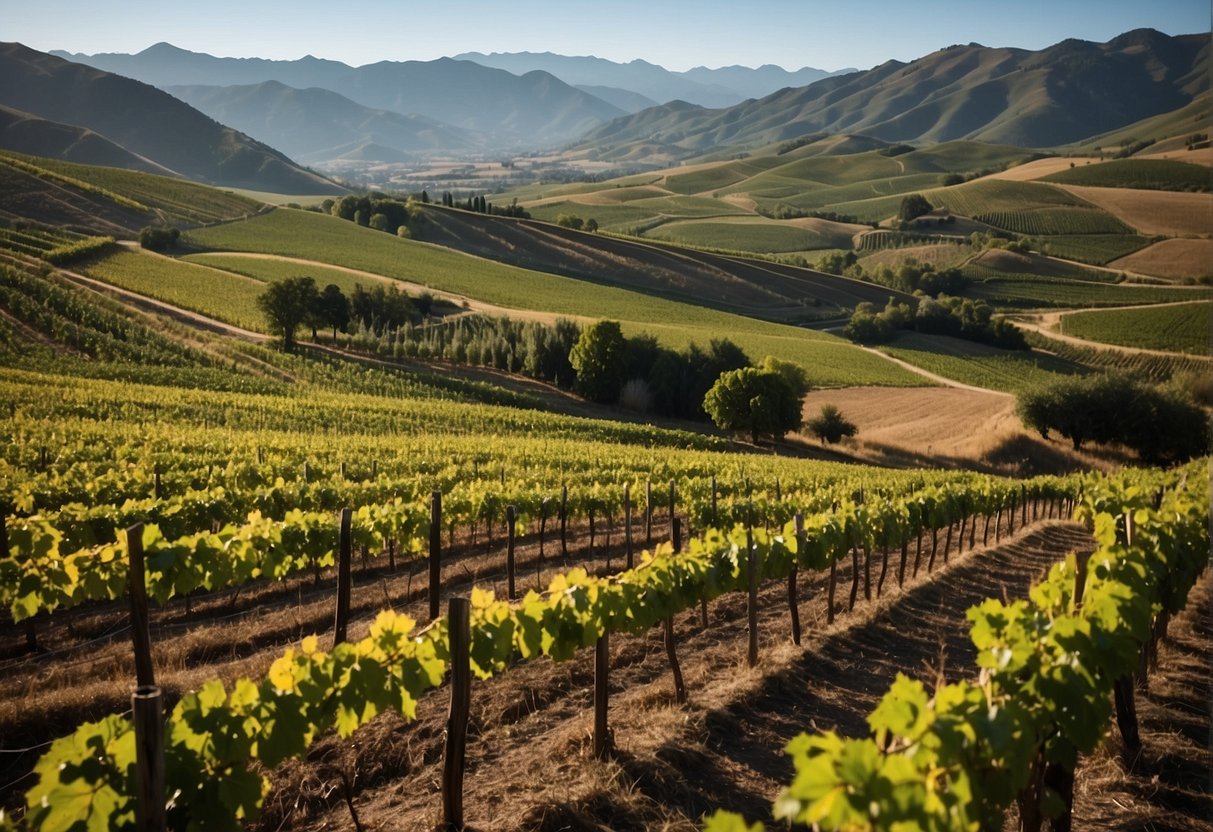
When you journey through Argentina’s diverse wine landscape, you’ll find a wealth of wine-growing sub-regions, each with its unique characteristics. The National Viticulture Institute regulates these areas, ensuring that wines reflect their origins.
In the heart of Argentina’s wine country, Mendoza is a name synonymous with fine wines.
Sub-regions like the Uco Valley, with areas like Tupungato and La Consulta, are celebrated for their high-altitude vineyards and distinct flavors.
Luján de Cuyo, Argentina’s very first DOC (Denominación de Origen Controlada), is known for producing full-bodied Malbecs that are rich and complex.
Moving south, into Patagonia, the cooler climates of Rio Negro and Neuquén are revered for creating wines with bright acidity and fresh, fruity flavors. These southern regions are gaining recognition for their Pinot Noir and Merlot.
San Juan, just north of Mendoza, prides itself on a drier and hotter climate, perfect for Syrah and Malbec. And not far, the sub-region of San Rafael balances between tradition and innovation, making it an exciting area for exploratory wine lovers.
Mendoza’s East Zone, featuring areas like Maipú, Santa Rosa, and Rivadavia, is warmer, fostering the growth of intensely flavored grapes. Here, you’ll discover robust reds and aromatic whites that encompass the spirit of the region.
The Business of Wine: From Producers to Exporters
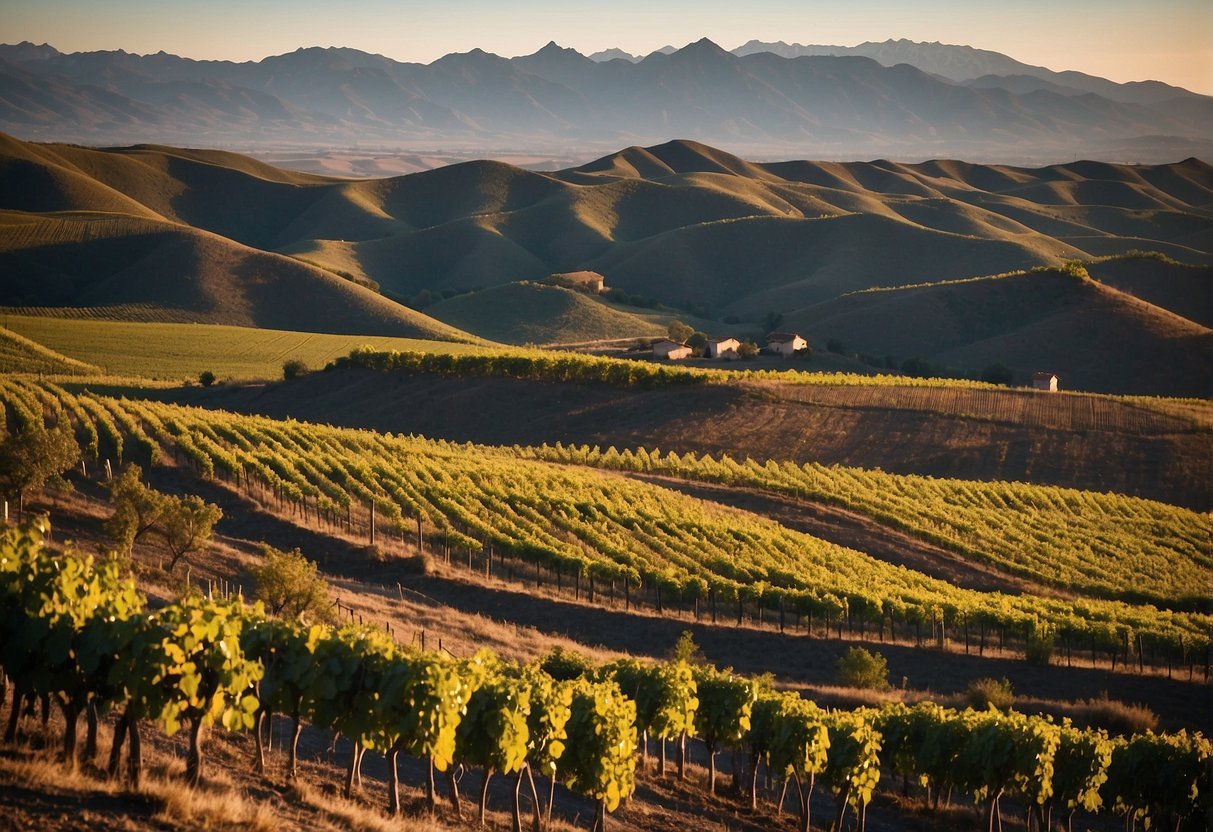
The Argentine wine industry is vibrant, with the region of Cuyo, and cities like Mendoza and San Juan, leading as the epicenter of wine production.
As a wine enthusiast, you’ve likely sipped on a Malbec from these regions, appreciating its bold flavors. What makes Argentine wine particularly noteworthy is not just the producers themselves but the journey from grape to your glass.
Producers: Local winemakers create vintages that reflect Argentina’s rich terroir. The production process involves careful vineyard management to ensure quality from the ground up.
Export Market: Wine exports have been a growing aspect of the business, with the Argentine wine industry reaching international markets. Your favorite Argentine wine may have journeyed from Buenos Aires ports to your local retailer, underscoring the global demand for these distinct wines.
In recent years, smaller producers have begun redefining the industry’s landscape, focusing on sustainable practices and boutique batches. These efforts not only boost domestic consumption but also appeal greatly to the export market, where uniqueness and quality are highly prized.
Argentina’s wines compete favorably on the international stage. Interestingly, Spain stands as a key player both as a competitor and consumer in the wine market.
Tracing the growth of Argentine wines, you’ll discover a blend of traditional methods and modern innovation that continues to propel the industry forward. The synergy between the enthusiastic producers and savvy exporters assures that your experience with Argentine wines remains fresh and exciting.
Cultural Impact and History
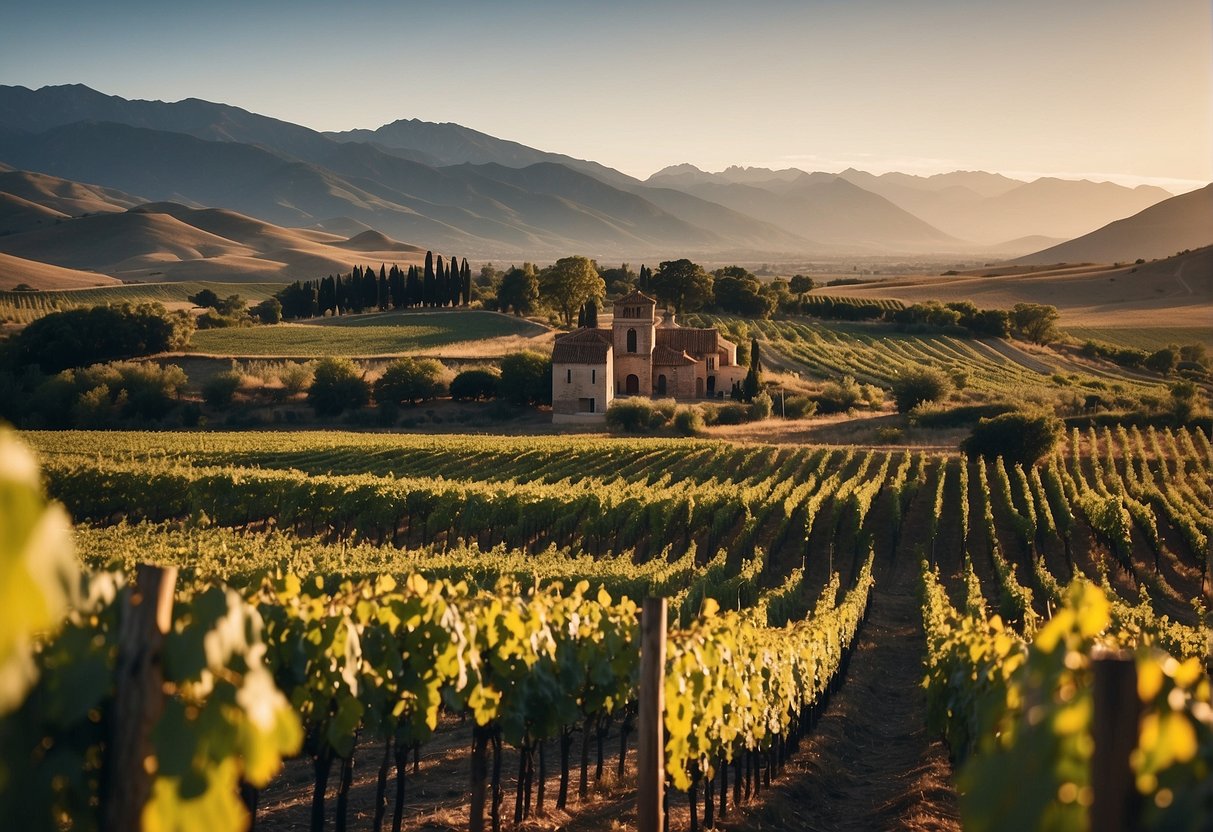
As you explore the rich tapestry that is Argentina’s wine heritage, you’re immersing yourself in a legacy that began with Spanish missionaries planting the first vineyards.
Throughout the centuries, wine has seeped deeply into the fabric of Argentinian culture, becoming as synonymous with the nation as tango or football.
Migrated grapes found a pleasant surprise in the soils of Argentina, especially in the Cuyo region. With a prime focus on the Malbec variety, it didn’t take long for Argentinian vintners to harness the potential of the local terroir.
The wine you taste from this region carries with it a history of adaptation and mastery over the unique Argentina Wine Country topography and climate.
Here’s a snapshot of Argentina’s wine landscape:
- Spanish colonial era: First vineyards, intended for religious purposes.
- 19th & 20th centuries: Influenced by European immigration, notably from Italy and Spain, which bolstered wine’s cultural significance.
- Modern-day: Encompassing familiar rituals and festivals, Argentine wine weaves together communities, symbolizing both everyday life and celebration.
Your glass of Argentine wine is more than just a beverage—it’s a celebration of a nation’s story. Each sip is testimony to centuries-old traditions blending with innovative techniques that place Argentina among the world’s leading wine producers. When you savor that Argentine Malbec, you’re part of a cultural continuum, bearing witness to an evolution that has shaped a country and delighted palates worldwide.
Frequently Asked Questions
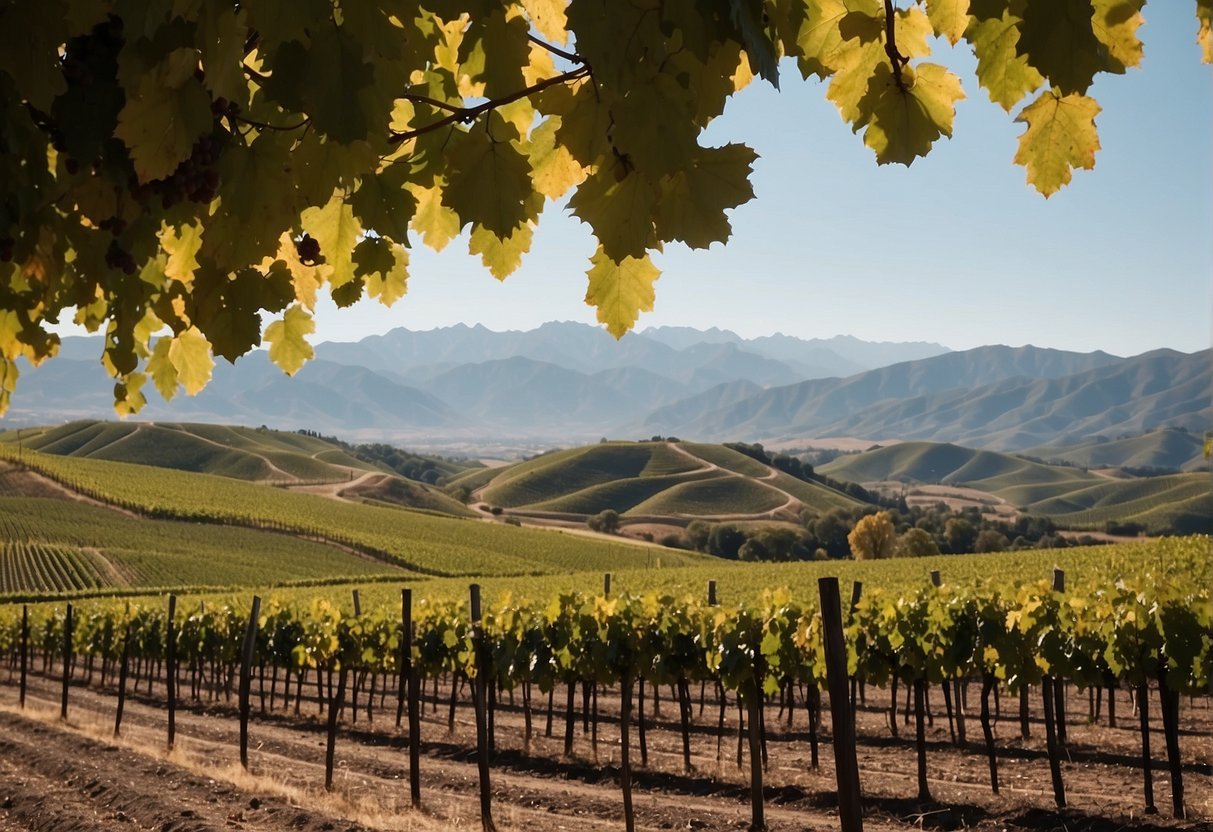
In this section, you’ll find answers to common inquiries about Argentina’s rich wine heritage and regions, helping you plan your next wine-focused adventure.
What are some of the top wine regions to explore in Argentina?
Argentina is home to an array of renowned wine regions.
You won’t want to miss the expanse of Mendoza, a region celebrated for its high-altitude vineyards and exceptional Malbecs.
Additionally, Salta offers unique flavors with vineyards situated at some of the highest elevations in the world, while Patagonia provides a cooler climate ideal for Pinot Noir and Merlot.
What kind of wine is Argentina most famous for producing?
Argentina is globally recognized for its Malbec wines. These are rich, full-bodied reds with dark fruit flavors and a smoky finish. Originating from France, Malbec has found a prosperous home in Argentina, particularly in Mendoza where the grape thrives.
When is the ideal time to plan a vacation to Argentina’s wine country?
Your perfect time to visit Argentina’s wine regions would be during the harvest season, which runs from March to April.
This is when the vineyards are bustling with activity, and the weather is sublime, making it an ideal period for wine tours and tastings.
Can you describe the impact of climate on wine production in Argentina?
Argentina’s wine regions benefit from a wide range of climates, from the hot, arid conditions in Mendoza to the cooler, windy climates in Patagonia.
These variations allow Argentina to produce a diverse selection of wines. High altitude and dry weather in places like Salta contribute to the development of grapes with a bold flavor and high acidity.
How has the history of wine in Argentina influenced its current wine culture?
Argentina’s wine culture has been shaped by centuries of winemaking practice, starting from Spanish colonization and later enriched by Italian and French influences.
This has created a rich tapestry of winemaking expertise, complementing the country’s native varietals and establishing Argentina as a powerhouse in the wine world.
Are there opportunities to purchase vineyards in Argentina and if so, what should potential buyers know?
Yes, there are opportunities to purchase vineyards in Argentina. Potential buyers should be aware of the importance of location. They should also consider the investment involved in maintaining vineyards and producing quality wine.
Furthermore, understanding the local market and regulatory environment is crucial before making such a significant investment.
